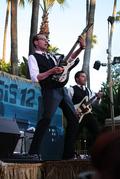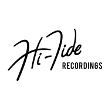Maybe some of you guys might know this stuff. It's not exactly Surf, but some of it is instro...
I got the "galloping" delay sounds of Hank Marvin - I had good success nailing Apache and Wonderful Land and a few others.
My understanding is Marvin, with The Shadows, never used Reverb, only Delay (and it was typically this rhythmic style of delay).
For The Ventures version of Walk Don't Run, I actually pulled up an Echo patch, rather than a soaky Reverb. There seems to be more "bounce" to it - more like a slapback - or it's reverb with an early reflection that's pretty prominent.
I understand that Duane Eddy used some kind of amp that had this built in Vibrato.
But a lot of those guys also had "echo" in the form of Slapback.
Now you hear guys on forums always talking about having only one repeat for slapback, but what I hear is typically more than one. And knowing how tape echo units of the day worked, it seems logical that there was going to be more than one repeat.
However, I also know that at Sun Studios they used a 2nd tape machine so there was only 1 repeat, and they piped it into an actual reverb "chamber" - a basement. This may have added some additional early reflections (it was a natural room after all).
At any rate, my trying to emulate it with an effect means that it's really a combination of echo and reverb, echo with multiple (but subtle) repeats, or a reverb that's very "early reflectiony" - which didn't come around until later tho...
Another post here mentioned Plate reverb on a unit being the sound of the Spaghetti Western sound. I know there are acutally a lot of different things going on there and what we hear in our heads as being iconic SW is probably a combination of various elements, or 1 particular sound. Still, I'd be interested if it was actually plate reverb used (they had them by then) on any that did have verb on them.
A "Brief History of Echo" is what I'm asking for - what developed when, which iconic recordings were which used on, etc.
For me, reading about an understanding how Marvin use delays instead of verb helped me to understand how to get that kind of sound. It also helped with David Gilmour and the Binson Echorec and I can nail those tones and get the general vibe as well.
I have a line 6 M13 and it's got a fair number of models, and some that aren't named, but clearly modelled after something well known (the manual does name some of them of course). So I have good luck finding the models that will do the sounds and get them dialled in.
What I'm lacking, I suppose, is in my "mind's ear" I'm kind of lumping anything "echo-y" (that isn't obviusly a long delay) as "spring reverb" when in fact, they could be Plate, Echo, Slapback+reverb, etc. and until I do the research as I did into Marvin, I don't quite know how to attain the sounds.
So knowledge about what type of repeat effects were used on various famous recordings of the "guitar-led" instrumentals of the 50s and 60s - would be most welcome. I'll take vocal-led pieces too - as I was interested in what Gallup used on his guitar, or if it was only studio (I don't think the Standels they think he played had any kind of echo, unlike the Echo-Sonic amp that I believe Scotty Moore played).
???

































